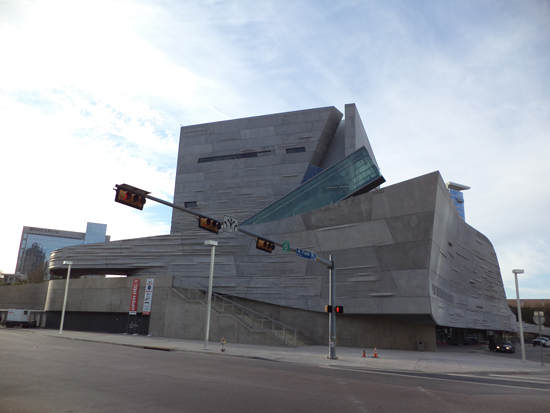High-Performance Aesthetics in Precast Concrete
Forms and Liners Used to Create Shapes, Macroscopic Designs, Patterns, and More
Concrete’s plasticity offers opportunity for innovation and individual character in surface textures, patterns, and shapes, all of which can be achieved by casting against the various types of formliners. A large pattern offers ever-changing details due to the play of light and shadow. A fine texture offers a muted appearance that is subtle but not drab. Smooth surfaces bring out the elegance and richness of simplicity. Formliner textured surfaces also mask minor imperfections that otherwise would be obvious in a smooth as-cast surface, yielding a more uniform appearance. Light and shade created by modeling or sculpturing with liners may be used for visual effect to enliven large concrete surfaces with low relief patterns. The options for combination finishes, involving one or more basic finishing methods together with formliners, are almost infinite.
Innovative patterns and designs can now be achieved by utilizing a combination of CAD and Computer Numerical Control (CNC) machining to produce custom formliners. CNC integrates computers into component manufacture, allowing for intricate pattern and form creation.
An important consideration lies in selecting the texture and/or type of formliner best suited to the project. If there are large wall expanses, a texture-like fractured fin with greater depth may give a more noticeable appearance with deeper shadowing. Shallow flutes, bushhammered, or subtle textures are often better for relatively small areas. When shallow patterns are used over large areas, subtle imperfections in the liner can give a mottled effect to the finished panel. Precast concrete can be produced with vertical ribs or striations in a range of sizes to suit a particular structure and the distance from which it will most often be seen.
Using Formwork Means Gaining Great Versatility in Forming and Details
A reveal or demarcation feature is a groove or step in a panel face, and generally is used either to create a desired architectural effect or to separate finishes or concrete mixtures. Another name for this is rustication or false joint. Reveals can be vertical, horizontal, diagonal, or curved forms, as well as any combination of these, and there may be several bands of them on a building. A superb example of this technique is the Nordstrom facade case study. Reveals can be narrow and delicate or deep, wide, and bold; they can offer a rectangular profile or take on any sectional shape desired, such as concave or triangular.
Reveals can be much more than a joint or line of demarcation between textures or finishes. Designing reveals in varying shapes, sizes, and depths for a precast concrete wall can transform what initially might be considered a mundane, solid surface into a rich play of shade and shadow, bringing visual interest to the building’s facade. Used effectively to create shadow lines, reveals offer the simplest way to reduce or change the building’s apparent visual scale, and to minimize any differences that may occur in texture or coloration between panels.
Reveals typically are designed where there are changes in the precast concrete’s surface. They allow a crisp, clean transition between different textures, finishes, colors, or profiles within a panel. For example, a shift in the panel’s finish from smooth to textured can be emphasized using a reveal at the point where the surface texture changes. Reveals also work well where fundamental materials change within a precast concrete panel, such as from an exposed aggregate finish to a non-exposed aggregate finish.
Architectural precast concrete provides the designer with virtually complete sculptural freedom and flexibility in shaping concrete into an articulated structure.
Concrete shapes are not limited to volumes enclosed within planer surfaces; they may also be radiused or rounded. Sculptured panels can produce building facades with distinctive, strongly modeled elevations having flat interior wall surfaces. High and low relief, straight-line geometric patterns, and practically any free-form shapes are possible. Returns are another component of form aesthetics, wherein rounded or spherical aggregates or light exposure may be created.










